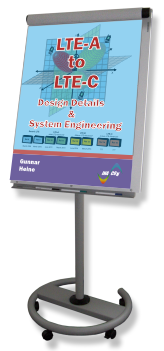 LTE-A to LTE-C Design Details & System Engineering
LTE-A to LTE-C Design Details & System Engineering
[2-day course, Euro 2,350.- (net) per participant]

From LTE to LTE-Advanced
LTE / LTE-A and their Playground
Genealogy of Cellular Radio
1st Generation, 2nd Generation, 3rd Generation, 4th Generation, 5th Generation
Requirements on a 4G-compliant Radio Technology
Detailed Description
History and Evolution Path of LTE
Generic LTE
LTE-A
LTE-B
LTE-C
Reviewing LTE Technology
Network Architecture: The EPC in Context with Legacy
EPC vs. EPS, Non-3GPP Access Networks (trusted / non-trusted), IMS and VoLTE, Zoom into EPS and E-UTRAN (Functional Overview of Core Network Elements within the EPC)
Protocol Stack
Control Plane, User Plane
Physical Layer of LTE…
Characteristics (OFDM , Scalable Bandwidth, Smart Antenna Technology, Extensive use of CDM, Duplex Modes), The Physical Resource: Frequency Bands for LTE (Part 1: Reserved for FDD, Part 2: Reserved for TDD), The OFDM Framework in LTE, Channels and Signals (1 Logical Channels:, Transport Channels, Physical Channels), Physical Signals (Downlink Synchronization Signals:, Downlink Reference Signals, Uplink Reference Signals), Organization of the Time-Frequency Grid (Regular Example, …with MBSFN-Subframe), Resource Allocation in LTE (Downlink, Uplink), Signal Processing Chain (The Term: "Codeword", The Term: "Layer", The Term: "Precoding"), The Transmission Modes (Transmission Modes and Antenna Ports)
The UE Categories with LTE-Advanced
Detailed Description
Carrier Aggregation
Types of Carrier Aggregation
Contiguous Intra-Band
Non-Contiguous Intra-Band
Inter-Band
Typical Application Scenarios of Carrier Aggregation
Cells are co-located and operate at similar Frequencies
F2 is primarily intended to improve Cell Edge Coverage
Hot Spots
Important Remarks about Carrier Aggregation
Meaning of a given CA-Configuration Term
Bandwidth Class and Bandwidth Combination Set
Example: CA-related UE-Radio Access Capabilities
Details
Practical Exercise: Examine SupportedBandCombination
Carrier Aggregation Configurations Rel 10 - Rel 12
Intra-band Contiguous
Bandwidth Arithmetic for Contiguous Intra-Band Carrier Aggregation (Part 1: Channel Spacing between Adjacent Carriers, Part 2: Nominal Channel Spacing for Carrier Aggregation, Part 3: Minimum Channel Spacing for Carrier Aggregation)
Intra-band Non-Contiguous
Inter-Band
Resource Management with Carrier Aggregation
PCell and SCell
Important Remarks
Activation of SCells
Cross-Carrier Scheduling
RRC-Measurement Reporting
Legacy Measurement Events during Carrier Aggregation
Detailed Description
The new Measurement Event A6
Measurement Gaps, Detailed Description
Layer 1 Uplink Control Information
Overview: SR, HARQ, CSI, PUCCH/PUSCH
Uplink Modulation in Rel 10
Clustered SC-FDMA
Relay Nodes, HetNets, ICIC, eICIC, feICIC
Welcome to the "Small Cells" Family…
Overview
Relay Nodes
Types of Relay Nodes (Type 1 Relay Nodes, Type 2 Relay Nodes), Use Cases, Interfaces (Detailed Description, The Un-Interface), Inband vs Outband Operation (Detailed Description), R-PDCCH and Subframe Timing, Why are small cells that important?
HetNet as dominant Network Configuration
Practical Exercise: HetNet vs Hierarchical Network
Range Extension
Detailed Description
Inter Cell Interference Coordination (ICIC)
Interference in the Cellular Environment
Conclusions for the LTE and LTE-A Environment
ICIC Option 1: Use different Set of Resource Blocks
ICIC Option 2: Fractional Frequency Reuse
Detailed Description
Practical Exercise: Liabilities of ICIC
enhanced Inter Cell Interference Coordination (eICIC)
HetNet with Macro Cell and multiple small cells
Protecting the control region…
The EPDCCH
EREG and ECCE
The Concept of Almost Blank Subframes (ABS)
Detailed Description
further enhanced Inter Cell Interference Coordination (feICIC)
Reduced Power ABS
Transmitter based Muting
Receiver based Puncturing
Receiver based Interference Cancellation
Advanced MIMO in LTE-A
Downlink Single User MIMO (SU-MIMO)
Support for TM 9 and 8 x 8 MIMO
DM-RS and CSI-RS
Precoding with TM 9
CSI-RS within the Physical Resource Block
Downlink Multi User MIMO (MU-MIMO)
Review: MU-MIMO in Rel 9
MU-MIMO in Rel 10
Uplink MIMO
Detailed Description
CoMP and C-RAN
Introduction to CoMP (Coordinated Multi Point Transmission)
Operation Principles
Primary Objectives
Relationship to Soft Handover
Relationship to Smart Antenna
Terminology
Cooperating Set, Measurement Set
Categories / Operation Modes
Joint Processing (JP)
Joint Transmission (JT), Joint Reception (JR), Dynamic Point Selection (DPS)
Coordinated Scheduling / Beamforming (CS/CB)
Scenarios
Scenario 1: Intra eNodeB CoMP
Scenario 2: Homogenous Network with central eNodeB
Scenario 3 and 4: eNodeB with Small Cells (HetNet)
Cloud or Centralized RAN (C-RAN)
The Idea and Architecture of C-RAN
VoLTE
Options of Voice Support over LTE
SRVCC
CSFB
SVLTE
VoLGA
FEMTO / PICO Cells
Over The Top (OTT)
IMS
LTE Voice Architecture with IMS
Operation of CSFB
Architecture in case of Circuit Switched Fallback (CSFB)
CS Fallback Solution Overview
CSFB Procedures
, Procedure Overview, The Principle of CSFB, Handover or Redirection
Example: CSFB for MTC from eUTRAN with Packet HO
Operation of SRVCC and IMS-based Solutions
Architecture in case of IMS-based Voice Services
VoLTE, ICS, SRVCC
IMS Centralized Services
UE enhanced for ICS, MSC-S enhanced for ICS
Architecture for IMS Service Centralization and Continuity
SCC AS , UE (normal or enhanced for ICS), MSC Server (normal or enhancements for ICS), IMS registration via CS access
Single Radio Voice Call Continuity (SRVCC)
SRVCC Evolution (eSRVCC, aSRVCC, rSRVCC, vSRVCC), SRVCC in Release 8, Enhanced SRVCC (eSRVCC) – Rel. 10, , Example: SRVCC from eUTRAN to GERAN with PS Bearer HO (HO Preparation:, Bearer Splitting:, PS to CS Handover Initiation, Relocation of PS Bearers, Session Transfer Initiation, Handover Execution, Session Transfer Signaling, CS Handover Completion, Deletion of the old voice bearer, PS Handover Completion, Additional Emergency Services Handling)
What else is on the Radar Screen?
Introduction and Overview
Various improvements…
FDD/TDD joint operation, New Carrier Type (NCT), LTE in unlicensed spectrum, 256-QAM, Machine Type Communication (MTC)
3D-MIMO
Carrier Aggregation with more than 2 Carriers
Part-time Cells
Interworking LTE <=> WiFi
Device to Device Proximity Services (D2D)
Use Cases
Mobile Relay
And what about 5G?
New Radio
Network Evolution
v1.011
Search:
More Info:
General Information about this course
Schedule of this training course
Buy this book
Our Training-Catalog
GSM Training Courses
(E)GPRS Training Courses
3G Training Courses
Multimedia & TCP/IP Training Courses
SS7 Protocol Stack Training Courses
Transmission & Access Technologies Related Courses
Bootcamps
